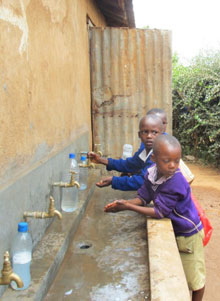Автор: By Vanessa Glavinskas
Ротарианците Walt Schafer и Sadikiel Kimaro са научили някои неша за устойчивите проекти по време на тяхната петгодишна съвместна работа по проекти за осигуряване достъп до чиста вода, канализация, и икономическо развитие в северните части на Танзания.
Schafer, a member of the Rotary Club of Chico, California, USA, and Kimaro, a member of the Rotary Club of Moshi, Tanzania, are in contact every few days, either by phone or by email.
“A personal connection with our partners is vital,” Schafer says of their relationship. He adds that their connection illustrates another key to making a project sustainable: working with a Rotarian contact who is part of the recipient community. Kimaro grew up in Mwika, one of the communities that has benefited from the projects.
The Chico and Moshi Rotary clubs have collaborated since 2008 on a series of projects, planting trees, providing schools with clean water, distributing deworming medication, and working on various community development initiatives. The efforts have benefited 50,000 people in Mwika and nearby villages.
To share what they have learned with other Rotarians, the clubs have created a video, “10 Key Points for a Successful International Rotary Project,” which appears on the project’s website.
It notes the importance of getting broad support from club members, involving multiple clubs, building a strong relationship between host club and its international partner, engaging local communities, conducting multiyear projects, and seeking local solutions.
Schafer said the collaboration began when he contacted the nonprofit Africare, prompted by his club’s goal to bring clean water to Africa. He learned there was a water need in the Mount Kilimanjaro region. Schafer then called Kimaro, who was president of the Moshi club at the time, and introduced himself, floating the idea that the clubs work together. Kimaro agreed, and so did their clubs.
“We started with water and sanitation and that’s basically all we did,” explains Schafer. “Then we decided to develop horizontally, that is, to do more broad community development rather than replicating water and sanitation in other areas that we didn’t know very well.”
The clubs looked to The Rotary Foundation’s six areas of focus as a guide and met with local community members to determine what was needed.
“By asking residents what they needed and staying true to the priorities, we ended up doing work in five of the areas of focus,” Schafer says. “It may look like a disconnected set of projects, but they are tied together by having single leadership in a single area.”
The clubs have used matching grants and club-to-club transfers to pay for the projects. As chance would have it, both clubs were in districts participating in the Future Vision Pilot, a three-year test of the Foundation’s new grant model, which launches worldwide in July.
The clubs were among the first to make use of an online application process for global grants.
“The application process has become much easier and much simpler for the global grants, because it’s all done online now,” Schafer says. “It was really complicated [before] and now that’s all done online. It’s a very user-friendly system.”
Adds Kimaro, “The substantial leveraging of resources that is possible under this process when more clubs and Rotary districts are willing to work together enables Rotarians to deliver sustained and substantial impact on needy communities.”
The clubs are now applying for their third global grant. If it’s approved, the total funding for the projects in northern Tanzania will reach about US$529,000. The next phase of the project will replace the entire community water system in Mwika, improve several medical clinics, bring solar power to a community library, and create a computer lab. The clubs also hope to expand a mentoring program for subsistence farmers in the area to help them market their produce.
“We have kept this going for so many years because that’s the best way to have a big impact,” Schafer says. “Many projects are in and out -- we’ve seen other nonprofits put things in and then there’s no follow-up. We’ve stayed involved both for sustainability and to have a larger communitywide model.”


